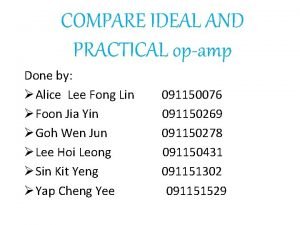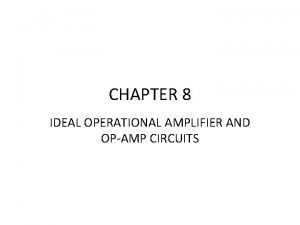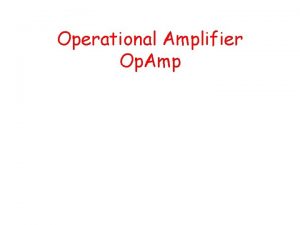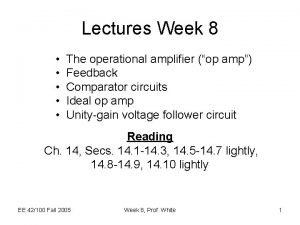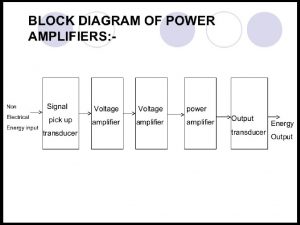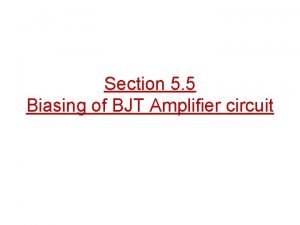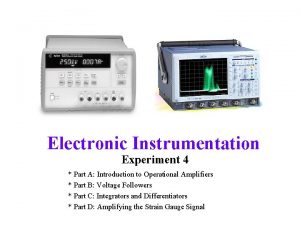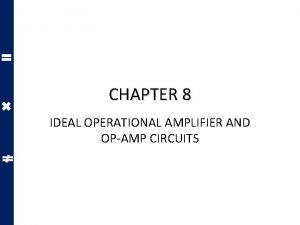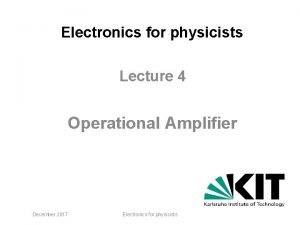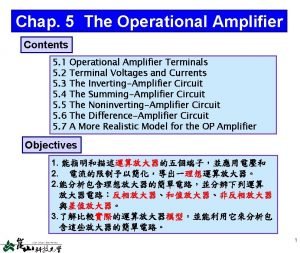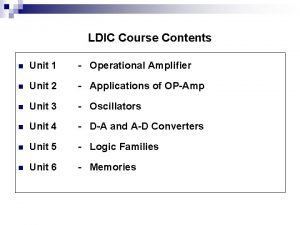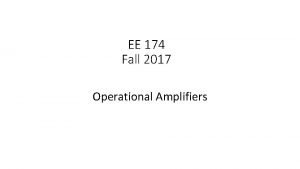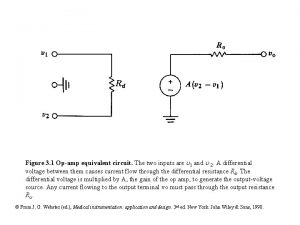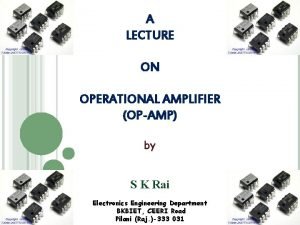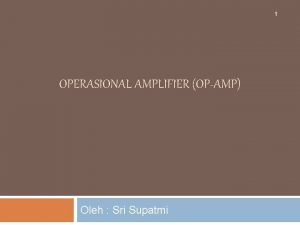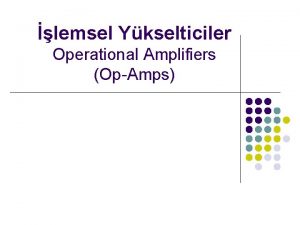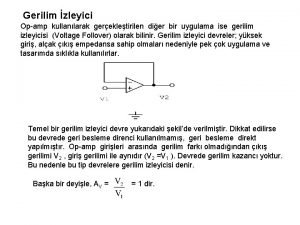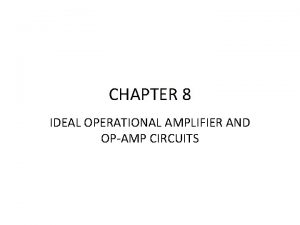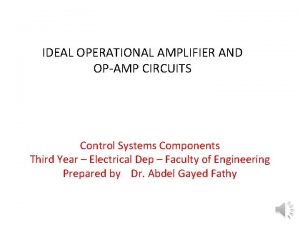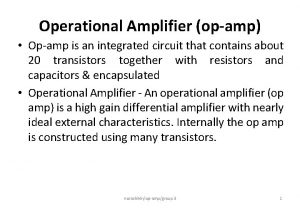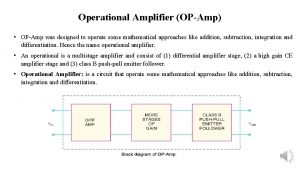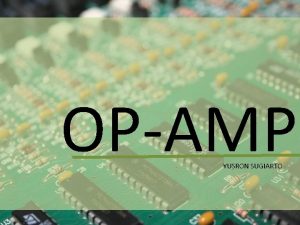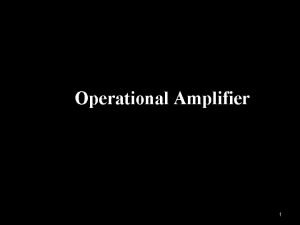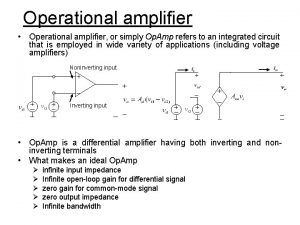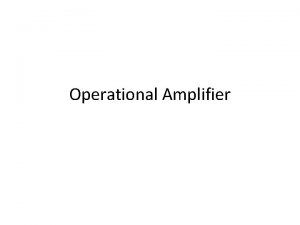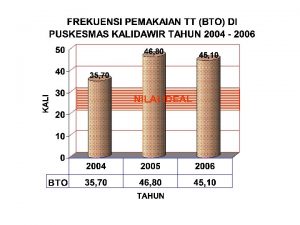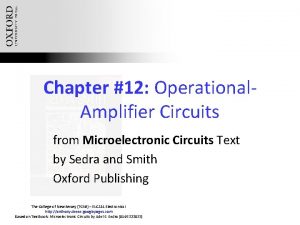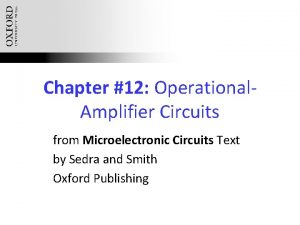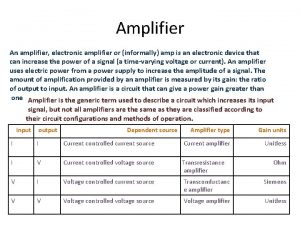CHAPTER 8 IDEAL OPERATIONAL AMPLIFIER AND OPAMP CIRCUITS





















- Slides: 21

CHAPTER 8 IDEAL OPERATIONAL AMPLIFIER AND OP-AMP CIRCUITS

inverting output non-inverting Op-amp circuit symbol • Open loop mode • Vo = Aod ( v 2 – v 1) – Aod is referred to as the open loop gain. – Notice that is v 2 = v 1, the open loop gain equals to

• Two main characteristics: • We want the open loop gain to be equal to which means that v 2 = v 1 0 0 • the input resistance to be equal to , hence there is no current going into the op-amp

• Op amp can be configured to be used for different type of circuit applications: – Inverting Amplifier – Non – inverting Amplifier – Summing Amplifier – Integrator – Differentiator

Inverting Amplifier Op-amp as an inverting amplifier Voltage at node 1 (inverting) = voltage at node 2 (non-inverting ) KCL at node 1: I 1 – I 2 – Iin = 0 (Vi – 0) / R 1 = (0 – Vo) / R 2 Vi / R 1 = - V o / R 2 Vo = - R 2 Vi R 1

Example 1 Gain = - (R 2 / R 1) = -(150/12) = -12. 5

Example 2 Answers: (a) - 6 (b) - 0. 27 V

Non - Inverting Amplifier Voltage at node 1 (inverting) = voltage at node 2 (non-inverting ) KCL at node 1: i 1 – i 2 = 0 (0– Vi) / R 1 = (Vi – Vo) / R 2 -(Vi / R 1) = (Vi / R 2) – (Vo / R 2) Vo / R 2 = (Vi / R 2) + (Vi / R 1) = Vi 1 + 1 R 2 R 1 Vo / V i = R 2 1 + 1 R 2 R 1 Noninverting amplifier

Voltage Follower / Buffer Amplifier vo = v. I Hence, gain = 1

Example 1 Answers: Vo = 5 V, Current = 1 m. A Vo = 10 V, current = 2 m. A

Summing Amplifier Similarly, i 1 + i 2 + i 3 – i 4 – 0 = 0 Example 8. 2 Design a summing amplifier as shown in figure to produce a specific output signal, such that vo = 1. 25 – 2. 5 cos t volt. Assume the input signals are v. I 1 = -1. 0 V, v. I 2 = 0. 5 cos t volt. Assume the feedback resistance RF = 10 k

Solution: output voltage

Other Op-Amp Applications

Integrator When the feedback resistor of an inverter circuit is replaced by a capacitor the circuit is worked as an integrator circuit -cause the output to respond to changes in the input voltage over time Integrator circuit

Example 1 Solution: The output voltage

Differentiator When the inverting input terminal resistor of an op-amp inverter circuit is replaced by a capacitor the circuit is worked as a differentiator circuit. Differentiator circuit Because Q = CVS

Example 1

Calculating Gain and Design Questions NON - INVERTING Calculating Output and Design Questions SUMMING AMPLIFIER DIFFERENTIATOR AMPLIFIER INTEGRATOR AMPLIFIER

Va NON - INVERTING Vb INVERTING Calculate the input voltage if the final output, VO is 10. 08 V. Finally: Va = (1 + 10/5) V 1 0. 504 = 3 V 1 = 0. 168 V Then: Vb = -(5/5) Va -0. 504 = - Va Va = 0. 504 V Have to work backwards: Vo = -(100/5) Vb 10. 08 = -20 Vb Vb = -0. 504 V

Va INVERTING SUMMING Calculate the output voltage, VO if V 1 = V 2 = 700 m. V Va = -(500/250) 0. 7 Va = -1. 4 V Then: Vo = - 500 [ Va / 100 + V 2 / 50 ] Vo = - 500 [ -1. 4 / 100 + 0. 7 / 50 ] Vo = 0 V

Calculate the output voltage VO of the operational amplifier circuit as shown in the figure. Answer: -3 V
 Compare ideal and practical op-amp
Compare ideal and practical op-amp Op amp exam questions solutions
Op amp exam questions solutions Amplifier applications
Amplifier applications Ideal opamp
Ideal opamp Compare voltage amplifier and power amplifier
Compare voltage amplifier and power amplifier Bjt
Bjt Multistage amplifier conclusion
Multistage amplifier conclusion Penguat operasional
Penguat operasional Operational amplifier experiment
Operational amplifier experiment Operational amplifier inverter
Operational amplifier inverter Operational amplifier
Operational amplifier Non inverting amplifier
Non inverting amplifier Operational amplifier block diagram ppt
Operational amplifier block diagram ppt Op amp formula
Op amp formula Operational amplifier is also called as
Operational amplifier is also called as Current in a parallel circuit
Current in a parallel circuit Equivalent circuit of op amp
Equivalent circuit of op amp Opamp sembolü
Opamp sembolü Open loop configuration of op-amp
Open loop configuration of op-amp Rumus vout op amp
Rumus vout op amp 709 op amp
709 op amp Gerilim izleyici
Gerilim izleyici
